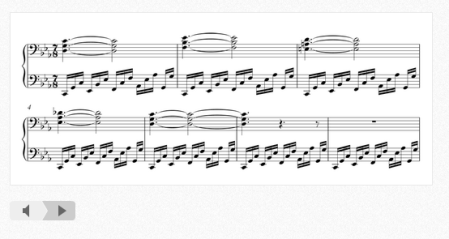
The summer grabbed hold of me in August—interference of the highest degree—so instead of writing about creativity and music I decided to live it for a bit. This Interference may have interrupted my routine and writing schedule, but it also fostered a restless mental energy that I’m finally getting around to scribing.
The Interference led to the following thoughts and discoveries I accumulated during the hiatus. They are scattered but pertinent…
 I discovered Capo thanks to Michael over at Daily Exhaust, and lamented never having it a decade ago while learning guitar. Dubbed “a musician’s best friend,” Capo lets you “slow down your favorite songs, so you can hear the notes and learn how they are played.” This is exactly what I sought after while struggling to learn music, but always had to settle for a MIDI-based guitar tablature playback program. Capo lets you change tempo and pitch (!), and incorporates markers to “bookmark” the portion of a tune you’re attempting to learn. You can even export your adjusted track and upload it to your iPod, for portable practice sessions. It’s a bit pricey ($49) but I would have bought it in a heartbeat if it meant bringing down Stevie Ray Vaughan’s “Little Wing” to a manageable speed and tuning while learning it in college. I probably could have saved hundreds of hours in frustrated practice sessions…
I discovered Capo thanks to Michael over at Daily Exhaust, and lamented never having it a decade ago while learning guitar. Dubbed “a musician’s best friend,” Capo lets you “slow down your favorite songs, so you can hear the notes and learn how they are played.” This is exactly what I sought after while struggling to learn music, but always had to settle for a MIDI-based guitar tablature playback program. Capo lets you change tempo and pitch (!), and incorporates markers to “bookmark” the portion of a tune you’re attempting to learn. You can even export your adjusted track and upload it to your iPod, for portable practice sessions. It’s a bit pricey ($49) but I would have bought it in a heartbeat if it meant bringing down Stevie Ray Vaughan’s “Little Wing” to a manageable speed and tuning while learning it in college. I probably could have saved hundreds of hours in frustrated practice sessions…
 I’ve be evaluating and re-evaluating the fate of the music industry these days. It is truly an Industry in Decline, and this NYTimes Op-Ed piece makes this clear. The article is concise and prescient (“…This is part of a much broader shift in media consumption by young people. They’re moving from an acquisition model to an access model.”), but it’s the graphic outlining music sales that is particularly sobering. People just aren’t buying music in physical format anymore. They’re barely buying at all. It makes you wonder if there is an industry for music outside of the live performance space. I’m beginning to doubt it…
I’ve be evaluating and re-evaluating the fate of the music industry these days. It is truly an Industry in Decline, and this NYTimes Op-Ed piece makes this clear. The article is concise and prescient (“…This is part of a much broader shift in media consumption by young people. They’re moving from an acquisition model to an access model.”), but it’s the graphic outlining music sales that is particularly sobering. People just aren’t buying music in physical format anymore. They’re barely buying at all. It makes you wonder if there is an industry for music outside of the live performance space. I’m beginning to doubt it…
As long as you’ve read the Op-Ed piece above, check out the following, also on the NYTimes website: Artists Find Backers as Labels Wane.
 The Father of the Electric Guitar, Les Paul, passed away on August 13th, 2009 at the age of 94. Despite the minor resurgence that arose in the wake of his death, his contribution to music is still vastly unappreciated and unrecognized. You must realize that this man not only pioneered overdubbing, reverb, and phasing effects, he invented multitrack recording. For those unfamiliar: multi-track recording is recording as we know it today. Those large consoles in recording studios, and Garageband, would not have been possible without Les Paul’s innovations. He also has his name on one of the most popular electric guitars ever: the Gibson Les Paul. Living in New York City, I had the chance of seeing Les Paul play at his legendary weekly gig at the Iridium Jazz Club in Times Square. I never bought a ticket—the price seemed too steep for someone just starting out in such an expensive town—but now it seems like an absolute bargain. There’s a lesson in there I’ll never forget…
The Father of the Electric Guitar, Les Paul, passed away on August 13th, 2009 at the age of 94. Despite the minor resurgence that arose in the wake of his death, his contribution to music is still vastly unappreciated and unrecognized. You must realize that this man not only pioneered overdubbing, reverb, and phasing effects, he invented multitrack recording. For those unfamiliar: multi-track recording is recording as we know it today. Those large consoles in recording studios, and Garageband, would not have been possible without Les Paul’s innovations. He also has his name on one of the most popular electric guitars ever: the Gibson Les Paul. Living in New York City, I had the chance of seeing Les Paul play at his legendary weekly gig at the Iridium Jazz Club in Times Square. I never bought a ticket—the price seemed too steep for someone just starting out in such an expensive town—but now it seems like an absolute bargain. There’s a lesson in there I’ll never forget…

I’m gearing up for another ramp-up of QuikCallus marketing, as more and more users are sending positive feedback my way. Looking to bring QuikCallus to the next level in 2010, and I’m laying the groundwork now. Also syncing up with colleagues to launch a new entrepreneurial initiative centered around budding business owners. I’ve been digging the promise of Creative Entrepreneurship these days, and am looking to bring it to the forefront. Exciting things to come…
 The iPhone has changed my life. For all you guitarists out there: download the Guitar Toolkit. Tuner, metronome, fretboard, and chord dictionary all in one. It’s cheaper, more robust, and more portable than any tuner you could buy in a guitar shop. And at $9.99 you can’t beat the price.
The iPhone has changed my life. For all you guitarists out there: download the Guitar Toolkit. Tuner, metronome, fretboard, and chord dictionary all in one. It’s cheaper, more robust, and more portable than any tuner you could buy in a guitar shop. And at $9.99 you can’t beat the price.

If you aren’t on Twitter yet, get on it. I’m posting there more frequently than BlogSounds, and am always looking for feedback and suggestions from followers. Fire up an account and start following stockyturtle (@stockyturtle). I’ll make it worth your while.




 Posted by Mark
Posted by Mark 
















